Zlender Images
Active, Starburst, Seyfert... Galaxies
Active galactic nuclei (AGN) are among the most luminous objects,
the most powerful energy sources in the universe and hence they
are the most distant markers that we can observe in space and
time. An AGN emits unusually large amounts of energy from a very
compact central source. This central powerhouse may be observed
directly in the cores of Seyfert galaxies, BL Lac objects, QSOs or
quasars. There is evidence that QSOs and Seyferts are located in
spiral host galaxies, while radio galaxies, BL Lac objects, and
radio-loud quasars have their homes in elliptical host galaxies.
Not at least HST-observations of the motions of stars and gas in
galactic cores, in addition to other arguments ( see quasar,
power-law spectrum, X-rays), strongly suggest that the energy
output is derived from the gravitational potential of a
supermassive black hole: the energy would arise from an accretion
disc of gas, spiraling into the black hole. This gas could come
from the interstellar medium of a spiral galaxy (especially when
perturbed by gravitational effects in interacting galaxies), from
the tidal disruption of stars near the black hole, or from flows
of intergalactic gas on to the central galaxy of a cluster of
galaxies, as the gas cools. The X-ray continuum spectrum of many
AGN features components of emission that are thought to be
reflected off the accretion disc of the black hole, producing a
reflection spectrum .
The table below is from Osterbrock 1989 and shows the
fractions of galaxies per unit volume.
|
Type
|
Number Mpc-3
|
|
Field galaxies
|
10-1
|
|
Luminous spirals
|
10-2
|
|
Seyfert galaxies
|
10-4
|
|
Radio galaxies
|
10-6
|
|
QSOs
|
10-7
|
|
Quasars
|
10-9
|
Approximate space densities
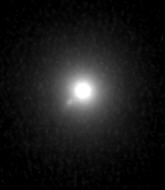 M87, Center of giant elliptical
galaxy in Virgo with Jet, 04/16/99, jpeg, 10k
M87, Center of giant elliptical
galaxy in Virgo with Jet, 04/16/99, jpeg, 10k
This image was made with my CG11 at F=2800mm. It is a
composition of 5 single shots of 20 seconds each. Jet
structures are a common phenomenon among radio galaxies (Virgo
A in this case, is one of the brightest sources). The knotty
appearance results when relativistic particles crash into gas
which is encapsulated inside the jet. The particles are
accelerated by a giant black hole of roughly 3 billion solar
masses. The jet has a length of 4000 light-years. It was
detected in 1918 by H. Curtis.
Ultra high resolution images from HST and VLBI.
Another image from 2003 was made with my 10" newtonian and the ST8-camera in 2003. Beside M87 and the jet it shows a larger field around this giant galaxy dominating the Virgo cluster.
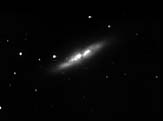 M82, Starburst galaxy in Ursa Major,
12/17/98, jpeg, 8k
M82, Starburst galaxy in Ursa Major,
12/17/98, jpeg, 8k
Images of M82 made in the light of H-alpha show
explosive filaments blowing away from the nucleus of this
galaxy. The temperature of H-alpha emitting gas is around
10000 K and may be heated by shocks and hot stars. The large
extent (around 6 kpc) of the emission results from a superwind
blowing out of the galaxy. The high supernovae rate in M82
(probably one every ten years) is thought to be the power
source driving this superwind. The assumed distance to M82 is
3.6 Mpc.
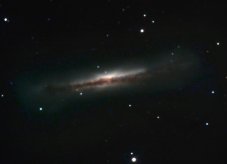 NGC 3628, Starburst
galaxy in Leo, 03/19/03,jpeg,78k
NGC 3628, Starburst
galaxy in Leo, 03/19/03,jpeg,78k
A starburst galaxy is, as the name indicates, a
galaxy in which a massive burst of star formation is currently
taking place: it is characterized by an infrared luminosity
that is considerably larger than its optical luminosity,
sometimes by a factor of 50 or more. The luminosity of
starburst galaxies can compare to the bolometric luminosity of
quasars, but is powered by a fundamentally different
mechanism. The starburst occurs in a region over a kilo parsec
in size, thus distinguishing these galaxies from active
galaxies, which have a tiny central powerhouse. A few nearby
starburst galaxies (e.g. M 82) have long been known from their
disturbed optical appearance, but their widespread occurrence
was only established when the infrared satellite IRAS revealed
thousands of them.
They are basically spirals in which the star formation is
proceeding at a rate that cannot be sustained for much of the
lifetime of the galaxy. The trigger for the burst of star
formation is unclear although in some cases the gravitational
effect of a companion galaxy may be responsible ( see
interacting galaxies). The new stars are still enveloped in
the galaxy's dense molecular clouds; their ultraviolet
radiation is absorbed by dust in the clouds and reradiated as
infrared.
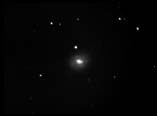 M77, Seyfert
galaxy in Cetus, 12/17/98, jpeg, 20k
M77, Seyfert
galaxy in Cetus, 12/17/98, jpeg, 20k
The 9.6mag bright M77 belongs to a special class of galaxies,
known as Seyfert galaxies. They have unusual
bright, almost stellar-like cores. Their spectra reveal broad
emission lines, almost invariably broader than those in
starburst galaxies and covering a considerable larger range in
ionization.
In Seyfert 1 nuclei a broad-line region (BLR) is found, in
which the internal velocities of gas and dust are large
(several thousand km/sec). These regions are surrounded by a
narrow-line region (NLR), where speeds are considerably
smaller. Seyfert 2 galaxies have spectra, in which the
permitted and forbidden emission lines have approximately the
same width. Their spectral features indicate that Seyfert 2
types lack the BLR region, or if they have one it must be
obscured. It has been speculated by some authors that the
difference between Seyfert galaxies of type1 and 2 might be a
projection effect, depending on the angle of view.
In this scheme M77 was listed as a Seyfert 2 object, until
Antonucci and Miller (1985) found that M77 shows in plane
polarized light, the spectrum of a Seyfert 1 galaxy.
Furthermore the plane of polarization is perpendicular to the
axis of the radio jet in its nucleus, a situation which is
interpreted as the result of a hidden BLR. No light can escape
directly from the BLR to the observer. Only photons escaping
along this axis of symmetry are scattered at some distance
from the nucleus and can be observed. As a result of this
scattering their mean plane of polarization will be
perpendicular to the axis. Since this detection eight
additional objects with hidden BLRs have been found.
M77 is the nearest and brightest representative of this class
of active galaxies, about 60 million light years
distant. Seyferts are often interesting variable
radio objects,( here Cetus A), and they are very prominent in
the infrared, where most radiation is emitted, and in X-ray,
too. Strong variability on the time scale of months is
observed at all wavelength, indicating a compact central
object. It is expected, that the powering machine is a
huge black hole of millions of solar masses.
Seyfert galaxies are thought to be intermediate between normal
galaxies and quasars (usually 100 times more powerful,
although the most luminous object in the universe is a faint
source IRAS galaxy (FSC 10214+4724), which shows a Seyfert 2
spectrum!).
The central spiral features in the above image are only
20"x50" small and over-exposed in most cases.
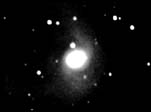 M77, with faint spiral arms, 12/17/98,
jpeg, 4k
M77, with faint spiral arms, 12/17/98,
jpeg, 4k
On deeper images (as the one above), faint, large spiralarms
can be traced out. In fact, with a diameter of 170,000
light years, M77 is one of the biggest galaxies in
Messier's catalog. Other famous Seyfert-Galaxies are NGC4151
and NGC1275 (see below), more than 150 others are known to
date. As Seyfert activity is probably only a transitory period
in the life of a galaxy, then it is possible that all giant
spiral galaxies, including our own, spend 10% of their lives
in a Seyfert phase.
As not only the central region shows a disrupted appearance,
M77 has also become a member of Arp's Atlas of Peculiar
Galaxies.
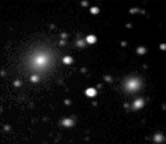 NGC 1275, Seyfert galaxy at the center
of the Perseus cluster, 12/17/98, jpeg, 13k
NGC 1275, Seyfert galaxy at the center
of the Perseus cluster, 12/17/98, jpeg, 13k
NGC 1275 is the central galaxy in the the Perseus cluster, 350
million light years away. Photographs in the light of H-alpha
show a system of long filaments, blown out by an explosive
event at 2400km/sec.
It is usually identified as a Seyfert galaxy, because it
has all the characteristics of that class of galaxies. A
long time ago, Walter Baade and Rudolph Minkowski have already
suggested that it consists of two galaxies passing through
each other. We nowadays know that refuelling with gas and dust
might stimulate activity in AGNs, so it might be a good
interpretation of what is going on here. In my opinion there
is a huge elliptical cD-galaxy, which is typical as a central
object of a cluster of galaxies and it has incorporated a
dusty spiral, where one of it's arms pears out to the north.
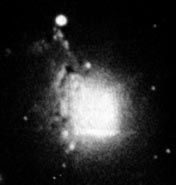 A
A 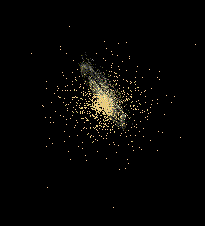 B
B 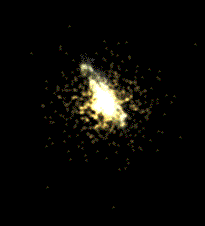 C
C
The 3 images above show NGC 1275,
-
A) a Mount Palomar image, as you can find it on page 1449
of Burnham's Celestial Handbook,
-
B) a screenshot of a
VRML
model I have made according to the idea
discussed here, and
-
C) a blurred version of the same image.
This view is supported by the fact, that NASA's Hubble Space
Telescope (HST) has detected many blue, that means young
globular clusters, as in NGC 4038/39 another famous pair of
colliding galaxies in Corvus. This is quite unusual, because
most globular clusters belong to
the oldest objects known.
A problem might be the rare occurrence of spirals in the Perseus
cluster.
 NGC 3786/88, Interacting pair of
galaxies, 05/16/99, 8 f/4.5, jpeg,18 k
NGC 3786/88, Interacting pair of
galaxies, 05/16/99, 8 f/4.5, jpeg,18 k
Here the original goal was to obtain an image of supernova
1999bu, discovered near to the center of NGC 3786, (1".3 west
and 3".1 south). But my equipment was unable to resolve this
17.6 mag sn in this unfavorable position. Then I learned, that
NGC 3786 is also a Seyfert galaxy, being partner in a pair of
interacting galaxies. The close encounter might be the reason
for the activity in the AGN that we observe here.
Comments welcome, contact:
 M87, Center of giant elliptical
galaxy in Virgo with Jet, 04/16/99, jpeg, 10k
M87, Center of giant elliptical
galaxy in Virgo with Jet, 04/16/99, jpeg, 10k




 A
A  B
B  C
C

